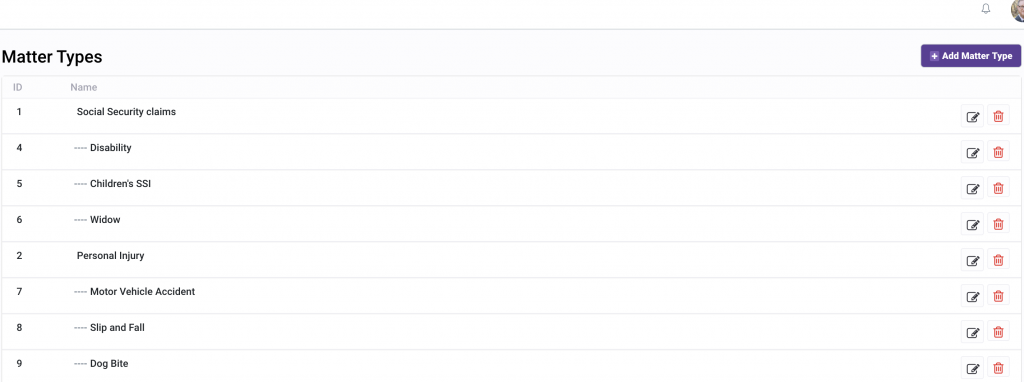Settings Overview
Settings
When you first start using Dendri you can dive right in and add contacts and projects and start using tasks, but there's a ton you can customize to get even more out of your experience. Let's look at a few of the key settings you'll want to spend some time with.

The Settings Menu
Board Types

The Board Type settings
Board Types let you build pre-defined kanban boards that can be associated with a particular matter type. So, if you know that a particular type of project or matter will always follow the same steps, you can create a fixed set of columns that will always be used in those cases. These will be Fixed Boards when attached to a matter type.
These boards will also be usable in assigning automation, so for example, you can have an email sent to the managing partner whenever a task is moved from "waiting on responses" to "response received." Because you know those columns will always be there, you can count on the result. Please review our dedicated help on automation, or reach out to us for help setting up your workflows.
Matter Type


List of Matter Types
You can set up specific matter types. Matters are essentially where all of the information and work for a case or project lives. They'll usually be associated with a client although they don't have to be. Setting matter types lets you associate a board type, but also allows you to add custom fields to the matter information and to set custom statuses.

Example of Matter Type with custom statuses (related to a Social Security case)
Only sub-types can be customized in this way. Parent types are best thought of as broad categories. If you only have one or two types of projects, you may just want to create a "general" parent. Parent types exist primarily to enable analytics and reporting.
Any custom fields can be used when exporting data, generating reports in future analytics features and generating documents.
Note Types

"Medical Record" Note Type
Notes are information recorded like tasks, but they don't appear in the kanban board and don't have discrete steps. Notes can be memos, phone calls, internal brainstorms, or any other info that you want to capture about your project.
Because they can be so many things, we've built Dendri so you can set up specific types of notes to meet your needs. In the example above, we've created a "medical record" request, to track the sending and receiving of a file. This has a couple of specific benefits.
First, in our short-term timeline, you'll be able to assign a custom icon to specific note types, you will also be able to filter by specific note types. So, while labels will do a lot of this, if you have a particular type of information you need to record, you will be able to synthesize that data down. Since anything on the history view can be exported to csv, you can pull the data you need off that table.
Second, you gain the benefit of custom fields to record specific information:

Custom note fields
Organization & Teams

Where you build your teams
Team boards are a way to organize tasks across matters onto an additional page that a team can work on together. Essentially a team dashboard works like your personal dashboard, but all members of the team can interact with the same view. So, if you have a team that focuses on drafting content, then every time a client needs a piece of content drafted it gets drafted and then all of that content can be organized for the team's workflow


